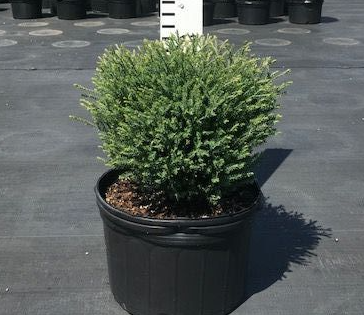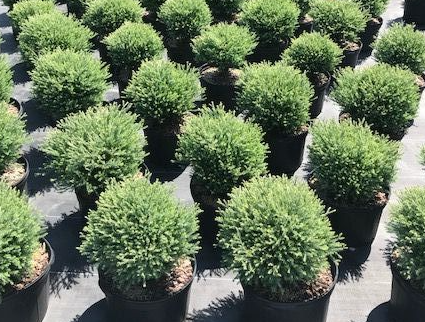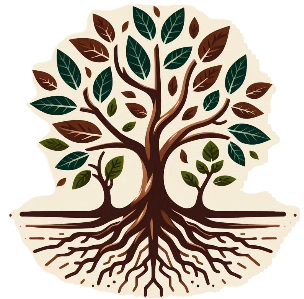Oakland Shade Trees & Nursery
Mr. Bowling Ball Arborvitae 'Bobozam', False White Cedar Thuja occidentalis
Mr. Bowling Ball Arborvitae 'Bobozam', False White Cedar Thuja occidentalis
Couldn't load pickup availability
Thuja occidentalis 'Mr. Bowling Ball' Arborvitae Description and Planting Guide
Description
Thuja occidentalis 'Mr. Bowling Ball' (also known as 'Bobozam'), commonly referred to as Mr. Bowling Ball Arborvitae or False White Cedar, is a compact, dwarf cultivar of the Northern White Cedar, prized for its unique, globe-shaped growth habit. This evergreen shrub grows to a mature height and width of 2 to 3 feet, forming a dense, rounded mound of soft, lacy, sage-green foliage. The finely textured, scale-like leaves remain vibrant year-round, offering a delicate, fern-like appearance that contrasts with coarser plants. Native to North America, particularly the northeastern U.S. and southeastern Canada, 'Mr. Bowling Ball' is a low-maintenance, slow-growing shrub ideal for small gardens and ornamental landscapes. Its tidy, spherical form and hardy nature make it a standout choice for adding structure and year-round interest.
Why Plant Thuja occidentalis 'Mr. Bowling Ball' in a Landscaping Project?
Compact Size: Its small, globe-shaped form is perfect for small gardens, urban spaces, rock gardens, or containers, fitting seamlessly into tight spaces without outgrowing its area.
Year-Round Appeal: As an evergreen, it provides consistent color and texture through all seasons, enhancing winter landscapes when deciduous plants are bare.
Low Maintenance: 'Mr. Bowling Ball' requires minimal pruning, is adaptable to various soil types, and is resistant to many pests, making it ideal for low-effort gardening.
Versatile Use: It shines as a specimen plant, in foundation plantings, mixed borders, or as a low hedge, adding structure and softness to garden designs.
Wildlife Support: While not as ecologically significant as the native species, it offers cover for small birds and supports local wildlife indirectly by hosting insects.
Deer Resistance: It is moderately deer-resistant, reducing the need for protective measures in areas with deer populations.
Grow Zone Information
Thuja occidentalis 'Mr. Bowling Ball' is hardy in USDA Hardiness Zones 3 to 8, thriving in a wide range of climates from cold northern regions to milder southern areas. It performs best in cooler climates with average summer temperatures of 60 to 75°F and can withstand winter lows down to -40°F in Zone 3. In hotter climates (Zone 8), it benefits from some afternoon shade to prevent foliage burn.
Planting Instructions:
Site Selection:
Choose a location with full sun to partial shade (at least 4-6 hours of direct sunlight daily) for optimal growth and foliage density. In hot climates, provide afternoon shade to avoid scorching.
Select well-drained, moist soil with a slightly acidic to neutral pH (5.5-7.0). It tolerates clay, loam, or sandy soils but does not thrive in waterlogged conditions.
Spacing:
Plant 2 to 3 feet apart to accommodate mature width, ensuring good air circulation. For low hedges or mass plantings, space 18 to 24 inches apart for a cohesive look.
Planting:
Timing: Plant in spring or early fall to allow roots to establish before extreme heat or cold.
Preparation: Dig a hole twice as wide and as deep as the root ball. Mix compost into the soil if drainage or fertility is poor.
Placement: Place the shrub in the hole with the top of the root ball level with the ground. Backfill with soil, gently tamping to eliminate air pockets.
Watering: Water thoroughly after planting to settle the soil.
Care After Planting:
Watering: Keep soil consistently moist during the first growing season, watering deeply once or twice a week. Once established, it is moderately drought-tolerant but benefits from occasional watering during dry spells.
Mulching: Apply a 2- to 3-inch layer of organic mulch (e.g., bark or wood chips) around the base, keeping it 2 inches from the stem, to retain moisture and protect roots.
Fertilizing: Apply a balanced, slow-release fertilizer (e.g., 10-10-10) in early spring to support healthy growth. Avoid over-fertilizing, which can lead to weak growth.
Pruning: Minimal pruning is needed due to its naturally rounded shape. Trim lightly in early spring to remove dead or damaged branches or to maintain size, using clean, sharp shears.
Winter Protection: In colder zones (3-4), protect young plants from drying winter winds with burlap wraps or windbreaks to prevent foliage desiccation.
Pest and Disease Management:
Monitor for pests like bagworms or spider mites, which can affect foliage. Treat with insecticidal soap or horticultural oil if infestations occur.
Watch for fungal issues like root rot in poorly drained soils or cedar-apple rust, which can affect nearby apple trees. Ensure good drainage and avoid overhead watering.
'Mr. Bowling Ball' is generally pest- and disease-resistant with proper care.
Additional Notes:
In hot, humid climates, ensure adequate air circulation to prevent fungal issues, and avoid planting in overly wet areas.
Pair 'Mr. Bowling Ball' with contrasting plants like purple heucheras, blue fescue, or taller evergreens like Thuja 'DeGroot’s Spire' for dynamic texture and color.
Protect from heavy snow loads in northern climates, as the compact form can trap snow and cause branch stress.
Consult local nurseries or cooperative extension services for region-specific advice, as soil and climate conditions vary.
By incorporating Thuja occidentalis 'Mr. Bowling Ball' into a landscape, you can achieve a low-maintenance, visually appealing design with year-round structure and charm.
Share




